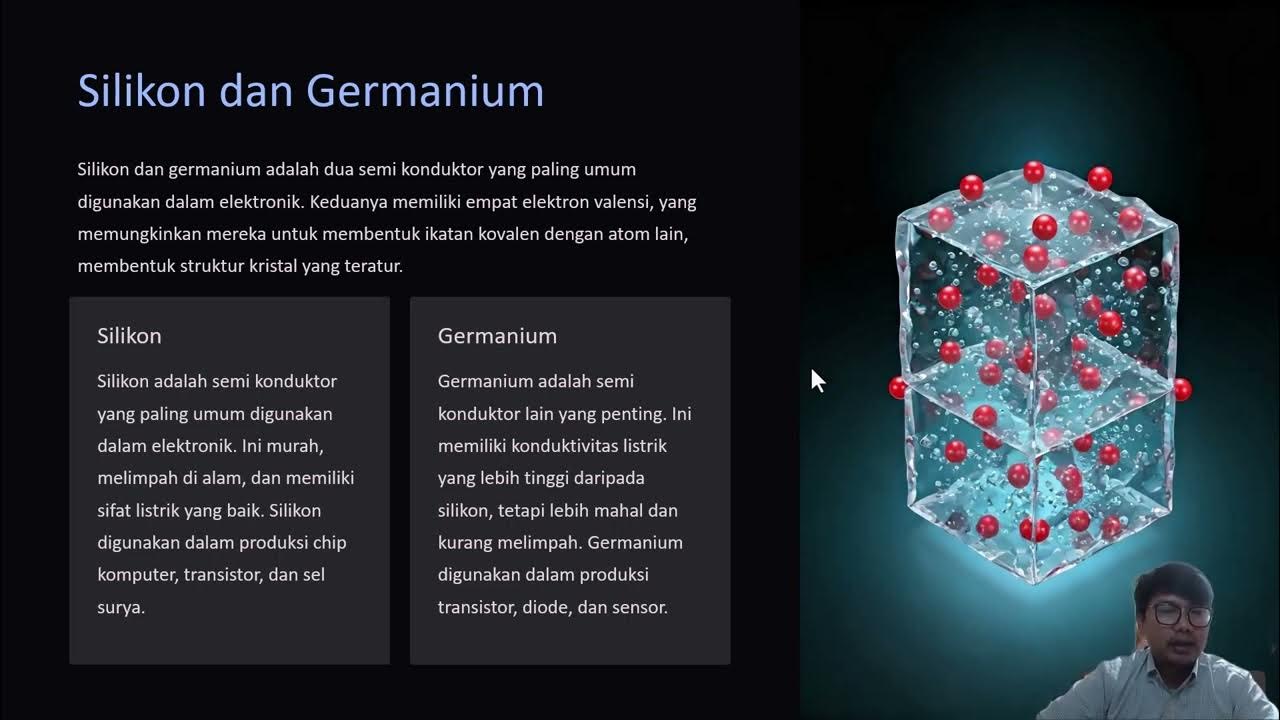Listrik Dinamis "Arus Listrik & Hantaran Listrik"
Summary
TLDRThis video explains the concepts of electric current and electrical conductivity. It covers how electric current flows through a closed circuit, powered by sources like batteries and generators, and how different materials conduct electricity. The video also discusses conductors, such as copper and silver, which are ideal for transmitting electricity, as well as insulators like plastic and rubber, which prevent current flow. Additionally, the importance of semiconductor materials like silicon is highlighted, especially in electronics. The concept of resistance and how it affects electrical flow is also introduced.
Takeaways
- 😀 Electric current is the flow of electrons through a conductor, and it can be controlled using a switch in a closed circuit.
- 😀 Electrical current depends on the potential difference (voltage) provided by a power source, such as a battery or generator.
- 😀 The direction of electric current is from high potential to low potential, while electrons flow from negative to positive terminals.
- 😀 Current can be calculated using the formula: I = Q/t, where I is the current, Q is the charge, and t is the time.
- 😀 Electrical conductors, such as copper and silver, allow electricity to flow easily, while insulators like plastic and rubber do not.
- 😀 Semiconductors, like silicon and germanium, have properties that make them useful in electronics, as they can act as both conductors and insulators depending on temperature.
- 😀 The resistance of a material determines how much it opposes the flow of electric current. It depends on the material, temperature, and length of the conductor.
- 😀 The formula for electrical resistance is R = ρ × (L/A), where R is the resistance, ρ is the resistivity, L is the length of the wire, and A is the cross-sectional area.
- 😀 The flow of electricity in a circuit can be affected by the type of material used in the wiring, with conductors providing less resistance to electron flow.
- 😀 Electrical appliances and household wiring rely on the principles of current, conductance, and resistance to operate safely and efficiently.
Q & A
What is the main topic discussed in the script?
-The main topic discussed in the script is the concept of dynamic electricity, specifically focusing on electrical current and electrical conduction.
What is the significance of Thomas Alva Edison’s discovery mentioned in the transcript?
-Thomas Alva Edison’s discovery of the electric lamp helped eliminate the darkness and fear of night, contributing to the rapid development of electrical technology.
How does electricity flow through a circuit?
-Electricity flows through a closed circuit. When a switch is turned on, a potential difference provided by a battery causes the flow of current from the negative terminal to the positive terminal.
What is the formula for calculating electrical current?
-The formula for calculating electrical current is I = Q/t, where I is the current in amperes, Q is the electric charge in coulombs, and t is time in seconds.
In the example provided, how is the amount of charge calculated for a current of 5 mA over 0.1 seconds?
-To calculate the charge, use the formula Q = I × t. Substituting the values, Q = 0.005 A × 0.1 s = 5 × 10⁻⁴ coulombs.
What is electrical conduction and what materials are mentioned as good conductors?
-Electrical conduction refers to the ability of materials to allow electric current to flow. Good conductors include copper, silver, and gold, with copper commonly used in household wiring.
What is the purpose of the plastic or rubber insulation around electrical wires?
-The plastic or rubber insulation around electrical wires serves as an insulator, preventing the flow of electric current outside the wire and ensuring safety.
What is the difference between conductors, insulators, and semiconductors?
-Conductors are materials that allow electricity to flow easily, such as copper. Insulators prevent the flow of electricity, such as plastic and rubber. Semiconductors can act as either conductors or insulators depending on temperature, such as silicon and germanium.
What is the role of semiconductor materials in electronics?
-Semiconductor materials like silicon and germanium are used to make components like transistors, which are essential in creating integrated circuits (ICs) for electronic devices.
How is the resistivity of materials related to their ability to conduct electricity?
-The resistivity of a material determines its opposition to the flow of electrical current. Materials with low resistivity, like copper, are better conductors, while those with high resistivity, like rubber, are poor conductors.
Outlines

هذا القسم متوفر فقط للمشتركين. يرجى الترقية للوصول إلى هذه الميزة.
قم بالترقية الآنMindmap

هذا القسم متوفر فقط للمشتركين. يرجى الترقية للوصول إلى هذه الميزة.
قم بالترقية الآنKeywords

هذا القسم متوفر فقط للمشتركين. يرجى الترقية للوصول إلى هذه الميزة.
قم بالترقية الآنHighlights

هذا القسم متوفر فقط للمشتركين. يرجى الترقية للوصول إلى هذه الميزة.
قم بالترقية الآنTranscripts

هذا القسم متوفر فقط للمشتركين. يرجى الترقية للوصول إلى هذه الميزة.
قم بالترقية الآنتصفح المزيد من مقاطع الفيديو ذات الصلة

Pengantar Semi Konduktor

Trabalho de Física - Eletrodinâmica

Electricity class 10 Full chapter in animation | NCERT Science chapter 12

SJEC Lectures: Engineering Physics - Electrical Conductivity in Metal 1

Electric Current & Circuits Explained, Ohm's Law, Charge, Power, Physics Problems, Basic Electricity

Electrical Resistivity and Conductivity - Superconductors & Supercapacitors - Engineering Physics 1
5.0 / 5 (0 votes)
